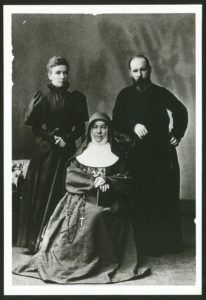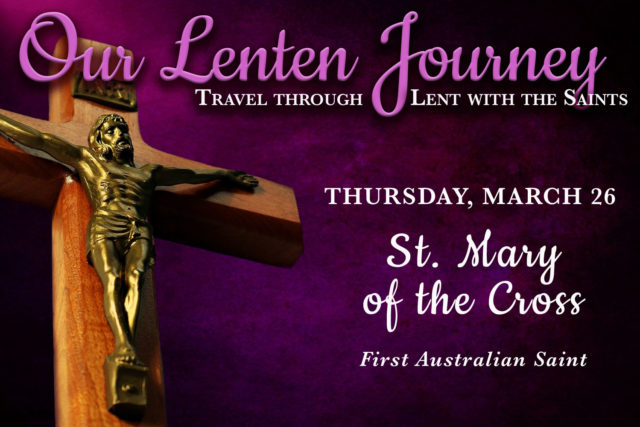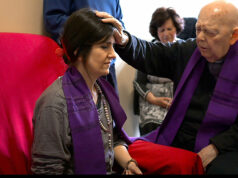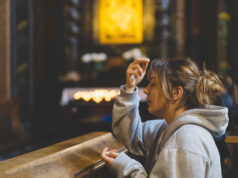How many saints do you know of who have been excommunicated? Joan of Arc comes to mind, however, she met a tragic end. You may not have heard of St. Mary of the Cross, the Australian nun whose fate was much better than that of St. Joan.
Mary Helen MacKillop was born in Melbourne on Jan. 15, 1842 to Flora MacDonald and Alexander MacKillop, Scottish immigrants who met and married in Australia. Alexander was a former seminarian, and had a good heart, but was unsuccessful at most professions, so the family struggled.
The oldest of eight children, Mary began working as a clerk at age 14. She later took a job as a governess for her aunt and uncle, followed by more teaching positions and running a school in Penola. During her teaching career, she always made an effort to include poor children from the area in her lessons. She felt that educating people was serving God.
In 1866, she met a young priest, Fr. Julian Tenison Woods, who invited her and two of her sisters to open a Catholic school in Penola. They opened a school in a former barn; it was a “free” school, taking no funding from the government (which was the norm) and accepting only what parents could pay. Mary wished to dedicate her life to God by serving the poor, and began wearing all black.

In 1867, she and other women involved with the school formed a new religious order, the Sisters of St. Joseph of the Sacred Heart of Jesus, also known as the Josephites. They were self-governing, rather than reporting to a bishop in a diocese. Mary officially took the name Sister Mary of the Cross. The order’s Rule of Life was very strict, emphasizing poverty and dependence on Divine Providence. The sisters lived in the community, rather than in convents, adopting brown habits. Locals nicknamed them the Brown Joeys.
The Josephites expanded their educational mission. They moved to Adelaide, and at the request of Bishop Sheil, founded a new school, the first school run by a religious order in Australia. More schools and institutions followed, with the majority of the people the sisters served living in Southern Australia. By 1869, they there were 70 nuns working in 21 schools. They also served in orphanages, reformatory homes, homes for the aged and incurable, and worked with the aging poor. The sisters travelled all over Australia to bring Catholic education to the common people.
By 1871, 130 nuns were working in more than 40 schools and charitable institutions across South Australia and Queensland. Then things took a strange turn for Sister Mary and the order. Accounts say that she and several other sisters reported a local priest for suspected abuse. The priest was sent back to his home country, but one of his peers launched a revenge campaign against Sister Mary that included accusations of alcoholism. Sister Mary refuted the claims, and argued with Bishop Sheil — who at the time also wished to take control of her order. As a result, Sister Mary was excommunicated by the bishop for insubordination in 1871. Many of the schools were closed and the nuns became homeless. The order survived, with the sisters living on charity from supporters. A year later, on his deathbed, Bishop Sheil admitted that he had been misled, and lifted the excommunication.
In 1873, Mary went to Rome to meet with Pope Pius IX and have the order and its Rule officially recognized. The pope accepted the order and the Rule, with some modifications made regarding the poverty rule. During this time, the Josephites flourished and expanded their mission to many other parts of Australia and New Zealand. Pope Leo XIII gave the final approval to the Sisters of Saint Joseph of the Sacred Heart in 1888.
In 1875, she was made Superior General of the Order, thus becoming Mother Mary of the Cross. She was removed by the local bishop in 1883, but brought back in 1899 and remained in that position until her death. In the intervening years, she assisted the superior in any way she could, writing letters and corresponding with many of the sisters.
Despite the ongoing clashes with clergy and bishops, the order thrived. By 1877 they operated dozens of schools, and also became active in prison ministry. In her later years, Mother Mary suffered health complications, including a stroke which disabled her right side. She needed to use a wheelchair; however she continued to write, learning to use her left hand.
Mother Mary died on Aug. 8, 1909 after years of ill health. After giving her last rites, Cardinal Moran, Archbishop of Sydney, said: “I consider this day to have assisted at the deathbed of a saint.”
After Mother Mary was buried, it became customary for visitors to her grave to take a handful of dirt from the gravesite. After a time, her remains were exhumed and moved to a vault in a chapel in North Sydney. The vault was the gift of her lifelong friend Joanna Barr Smith, a Presbyterian.
She is the first Australian saint. She is the patron saint of the Archdiocese of Brisbane. Her feast day is Aug. 8.
Pope Benedict XVI prayed at her tomb during his visit to Sydney for World Youth Day in 2008. He later canonized her in Oct. 2010.
A postage stamp was issued in her likeness to coincide with her canonization. Movies and plays have been written about her as well. One of the ferries in the Sydney harbor is named after her.
There is a shrine to her in her parent’s native Scotland: https://www.rcdai.org.uk/saint-mary-of-the-cross-mary-mackillop/
There is also a rose named for her, the MacKillop rose. https://www.sosj.org.au/product/st-mary-mackillop-rose-bush/







